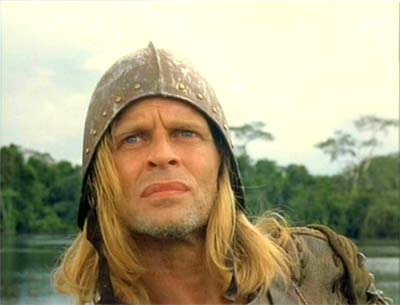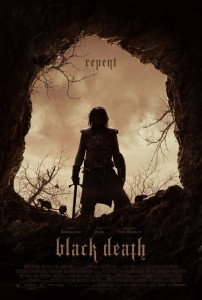
I admit while wiggling into my seat as the picture started, I thought Black Death was going to be a real grind – some kind of meaningless Medieval splatterfast. But behold. Here actually is an interesting and compelling film about the bubonic plague that demonstrates filmmaking integrity. Director Christopher Smith was in Los Angeles to speak about the film. “We are a species that can turn on each other when we don’t understand each other,” he says.
Smith’s approach isn’t historical drama, it’s more its own unique genre: historical horror. Prior to this, Smith made the sick-funny horror flick “Severance.” Smith recalls, “The writer of that film James Moran was on the London underground one day and a bunch of yuppies, trader boys, were talking too loud and being annoying. He said he went home to write a script to kill me some yuppies. I don’t think it was ‘The Office’ as intended, but it did become something like ‘The Office’ meets ‘Deliverance.’ That is an accurate summation, but I would toss in “The Most Dangerous Game,” too.
With “Black Death,” Sean Bean (“The Lord of the Rings,” “Goldeneye”) is cast as a mercenary soldier who embarks on a mission to slay witches and to bring Christianity to the pagans. Eddie Redmayne (“The Good Shepherd,” “The Other Boleyn Girl”) is cast as the young monk untested in his faith. Ulric and his army of men, with the monk as the guide, trek to a village where it is rumored that sacrilege runs interminably.

To see this story done is to diminish expectations. But somehow Smith does justice to its content as well as making it exciting. He explains, “I know it’s not hard to make that period funny. It’s harder to make that period not funny and make it realistic and scary.” But he is just as concerned with resonance as he is with realism. “I wanted to bring in a sense that it is an important story today. When you look at all the classic horrors, one model being the ‘Invasion of the Body Snatchers’ films, they all have a subtext that is relevant with contemporary times.”
In his film, it’s religion that drives the Church, knights, disbelievers and pagans to deadly crimes. Smith’s viewpoint is that the plague is killing off half the population yet there is still time for people to torture and kill each other. This makes Smith a target for simplifying religious fervor as the reason for mass murders – most men within the film are more than ready to crucify any woman suspected of witchery. He attempts to be diplomatic. “When we have the village at the end that is occupied by pagans or atheists, we are not sure, I didn’t want to be too specific,” he explains.
No need for Smith to apologize. He has created a vision. Among the remarkable facets are the grungy Middle Ages costumes and the bare but effective art direction of the villages. Smith speaks of inspiration: “We just looked at movies like ‘Aguirre the Wrath of God,’ ‘The Name of the Rose,’ the 1973 version of ‘The Wicker Man,’ the world is chaos and it’s crazy and it’s trying to get that spirit into the production design so it feels authentic and dirty. In attention to detail, the costumes were right and we found that village and just added to it with our own embellishments.”
I ask him again about “Aguirre the Wrath of God” (1972). “Yes, it is absolutely one of my favorite movies. Sean [Bean] is my Klaus Kinski.”

Like “Aguirre” and most of “Apocalypse Now,” Smith had the rare filmmaking opportunity to shoot his film almost entirely in sequence. Smith explains: “We looked at the locations and looked at the map, and we are there and there and there, in order. What I learned from shooting in order is you get this vibe that’s more forceful and committed.” In the press notes producer Jens Meurer comments, “The continuous shoot somehow welded the crew and especially the cast together in a way that you don’t normally see.”
Any downside? Smith has one, he explains, “What I do know is don’t shoot the first scene first and the last scene last. You’re in dispute the first day and rushing your last day.”
What is of utmost importance, if anything at all, is for a filmmaker to devote himself to the original purpose and concept of the screenplay, which Smith has. “Our screenwriter Dario Poloni’s conception was to create a battle of the Church versus the devil for the soul of this young boy, the monk Osmund,” and continuing, “Osmund leaves the monastery and heads to the village but realizes these men are not on a mercy mission, they’re on a mission to kill a necromancer [magician of witchcraft].” What “Black Death” plunges into is an age of fundamentalist killers, and this production does it tactfully, fearlessly, and ingloriously.





